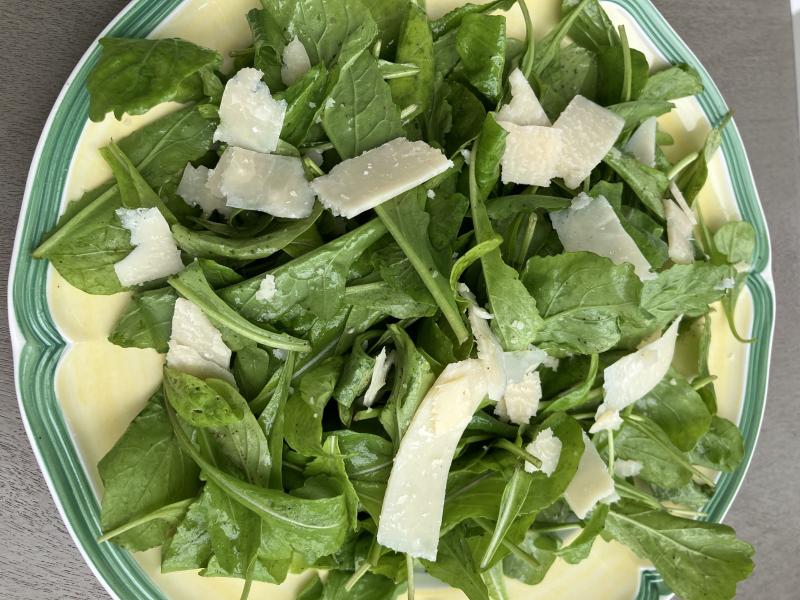Arugula can rocket your taste buds into a new dimension
Except for the ubiquitous wedge salad, it’s uncommon to find iceberg lettuce on a restaurant menu anymore. It will sometimes be added to a sandwich or burger as garnish or to provide a nest for a tomato slice, but it’s usually too limp to add any interest to a dish. Considered a novelty when it was introduced by Burpee at the end of the 19th century, it soon became the reliable head of lettuce chosen for almost all salads.
Yet, like so many trends, whether food or fashion, what was old has become new again. Before the year-round, industrialized California supply of iceberg lettuce became a constant in the market, lettuces were grown and harvested locally, a practice that returned in the 1970s led by Alice Waters, chef at Chez Panisse, one of the earliest to source organic produce from local farmers.
By the time David Kamp published his book, “The United States of Arugula,” in 2006, the tradition of seeking out colorful, tasty lettuce types had taken hold in foodie culture. You can see evidence of the popularity of baby lettuce varieties and lettuce mixes, like mesclun, lined up in plastic clamshell boxes at the supermarket. And the trend persists, as seen under the tents at the Historic Lewes Farmers Market on any Saturday in season.
The triple-washed baby arugula from Hatties’ Garden has always been one of my favorites, tempting me to open the bag and start nibbling before I reach my car for the trip home. The name for these sharp, spicy greens comes from the Italian word rucola and sometimes ruchetta or rughetta. In the British Commonwealth countries, it’s known as rocket, borrowing from the French term roquette.
Regardless of how we refer to it, this plant and its peppery-flavored leaves have been around for thousands of years. Ancient Greeks celebrated its medicinal value as a restorative, while the Romans considered it an aphrodisiac and banned it from monastery gardens. The latter belief has some basis in fact, as research studies with mice have shown arugula boosted testosterone levels and sperm activity.
Whether or not you’re on a date, eating arugula delivers a nutritional powerhouse to your system, with significant levels of vitamins A, B, C and K, along with calcium, potassium, magnesium, phosphorous, zinc, iron and phytonutrients. The best way to preserve these benefits is to serve arugula raw. Its flavor is not mild, often described as mustard-like, bright and bitter, making it a great partner for other strong flavors.
For the salad in the photo, arugula leaves were tossed with a lemony vinaigrette and topped with shaved Parmesan cheese. Arugula provides great flavor and texture interest when thrown on your pizza after it comes out of the oven, or substituted for basil in a pesto. Use arugula as a bed for a filet of grilled salmon or roast chicken. It works very well in a steak salad, especially when topped with bleu cheese.
I’ve included a recipe for the simple salad in the photo, which, although designed to serve two people, can easily be finished by one. There’s also the New York Times version of arugula pesto that uses walnuts instead of pine nuts. I like to add a little lemon juice, but you can decide whether it needs a splash or not. Finally, there’s a flat-bread pizza with mushrooms and ricotta, topped with arugula. Be sure to eat some rocket!
Arugula Parmesan Salad
1 T olive oil
1 T lemon juice
2 C arugula
1/4 C shaved Parmesan cheese
salt & pepper, to taste
In a serving bowl, whisk together olive oil and lemon juice. Add arugula and toss to coat with the vinaigrette. Scatter Parmesan on top, and season to taste with salt and pepper. Yield: 2 servings.
Arugula Pesto*
2 garlic cloves, halved
1/4 C shelled walnuts
2 C stemmed arugula, tightly packed
1/2 t salt
1/2 C olive oil
1/2 C grated Parmesan cheese
Combine garlic, walnuts, arugula and salt in the bowl of a food processor. Pulse intermittently until the arugula is finely chopped. Turn on power and slowly drizzle in olive oil. When the mixture is smooth, stop and scrape down the sides; process for another 30 seconds. Scrape out into a bowl and combine with cheese to form a smooth paste. Serve over pasta or as a sandwich spread. *Adapted from the New York Times.
Mushroom & Arugula Tart
1 sheet puff pastry
1 T olive oil
8 oz mushrooms, quartered
2 pressed garlic cloves
1 C ricotta cheese
1/8 t freshly grated nutmeg
2 T chopped parsley
1/8 t white pepper
1 C arugula
Preheat oven to 425 F. Line a rimmed baking pan with parchment paper. Unroll pastry and place in pan; score a border 1/2-inch from the edge. Bake until golden and puffed, about 15 minutes. While the pastry cooks, heat olive oil in a skillet over medium high. Add mushrooms and cook until liquid releases, about 8 minutes. Stir in garlic and cook another minute; set aside. Remove the pastry from the oven and deflate puffed center. Combine ricotta with nutmeg, parsley and pepper. Spread ricotta over the pastry, top with mushroom/garlic mixture. Bake for 5 minutes. Remove from oven and scatter arugula over the top. Yield: 4 servings.



















































